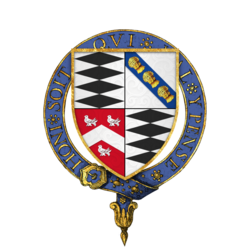John Savage | |
|---|---|
 Arms of Sir John Savage as a Knight of the Garter | |
| Born | c.1444 Cheshire, England |
| Died | October, 1492 (aged 47–48) Boulogne, France |
| Buried | The Savage Chapel, St Michael's Church, Macclesfield, England |
| Allegiance | |
| Rank | Knight banneret |
| Battles / wars | |
| Awards | Knight of the Order of the Garter Knight of the Bath |
| Spouse(s) |
Dorothy, Lady Savage
(m. 1470) |
| Children | Sir John Savage, George Savage (ill.), Alice Savage, Felicia Savage, Ellen Savage, Maud Savage |
| Relations | Thomas Stanley, 1st Baron Stanley (grandfather) Sir John Savage (father) Lady Catherine Savage née Stanley (mother) Archbishop Thomas Savage (brother) Thomas Stanley, 1st Earl of Derby (uncle) Sir William Stanley (uncle) George Stanley, 9th Baron Strange (cousin) The Savage baronets The Viscounts Savage The Earls Rivers The Savage family |
Sir John Savage, KG, KB, PC (1444–1492), was an English knight of the Savage family, who was a noted military commander of the late 15th-century. Savage most notably fought at the Battle of Bosworth Field in 1485, where he commanded the left flank of the Tudor (Lancastrian) army to victory and is said to have personally slain the Duke of Norfolk in single combat. Earlier in the Wars of the Roses, Savage had been a supporter and friend of the Yorkist King Edward IV, fighting alongside him and helping him to victories at the Battle of Barnet in April 1471 and the Battle of Tewkesbury the following month. He returned to active military service in 1482 when he joined the invasion of Scotland led by the King's brother Richard, Duke of Gloucester, where the Duke made him a Knight banneret.
However, following the death of Edward and the Duke of Gloucester's ascension to the throne as Richard III, the Savage family was viewed with suspicion due to their familial connection to the Stanleys, who were in turn connected to the Tudors. Consequently, Savage was one of the prominent figures who invited Henry Tudor to invade England in 1485, a struggle which culminated in the Battle of Bosworth Field. After his victory, Henry Tudor received the circlet of Richard from Savage's uncle, Lord Stanley, and was crowned King of England on the field of battle, taking the throne as Henry VII of England.
The year following his victory at Bosworth, Henry VII sent Savage to arrest Sir Humphrey Stafford and his brother Thomas Stafford, who had risen up against the king in the first major challenge to Henry's reign. Savage led a force to Culham where the two were seeking sanctuary and had them forcibly removed. The brothers were tried and found guilty, Sir Humphrey was executed whilst Thomas was pardoned. This event was notable enough for Pope Innocent VIII to announce a papal bull which established modifications affecting the privilege of sanctuary, significantly limiting its practical use and vindicating the actions taken by Savage on behalf of the King.
Savage later served as one of two main cavalry commanders at the Battle of Stoke Field on 16 June 1487, where leading Yorkists fought to put the pretender Lambert Simnel on the throne. This was the final battle of the Wars of the Roses, with the engagement ending in a decisive victory for the Tudors and leaving nearly all of Henry's Yorkist opponents dead. In 1492, Savage raised a force of men-at-arms and archers and joined Henry's expeditionary force to France. The campaign was intended to stop the French King Charles VIII's support of the pretender to the throne of England, Perkin Warbeck. Savage would not return to England alive, losing his life during the Siege of Boulogne.
Savage was a supporter successively of Edward IV of England who appointed him a Knight of the Bath on the occasion of his Queen's coronation on 26 May 1465, and Henry VII, who appointed him a Knight of the Order of the Garter in 1488. Savage also served as a member of Henry VII's Privy Council.
